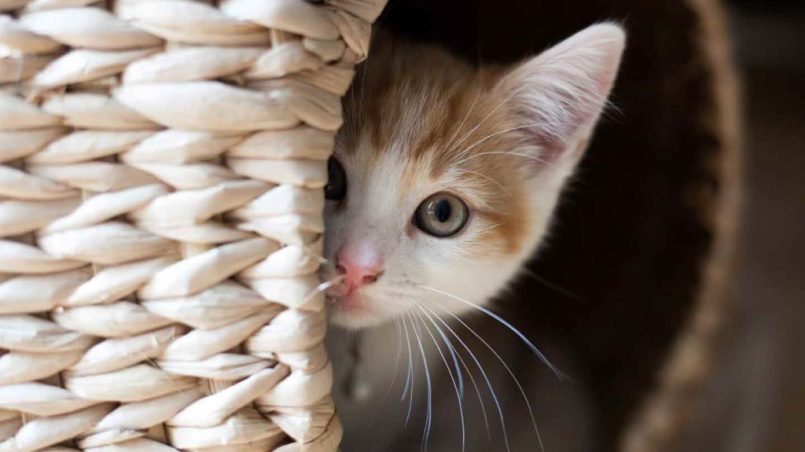Does your feline friend flinch at unfamiliar sounds or hide under the bed when guests arrive? You’re not alone. Many cats experience anxiety, exhibiting fearful behaviors that can be frustrating for both the cat and the owner. But fear not (pun intended!), with patience, positive reinforcement, and a calm environment, you can help your shy kitty blossom into a more confident companion.
Understanding Feline Anxiety
Before diving into solutions, let’s explore the reasons behind feline anxiety. Common triggers include:
- Lack of Early Socialization: Kittens in the 2-7 week window have a critical socialization period where exposure to positive experiences with people and other animals builds confidence. Cats who miss this window may be more prone to anxiety later in life.
- Negative Experiences: Loud noises, sudden movements, or past trauma can leave a lasting impact, making cats wary of new situations or people.
- Underlying Medical Conditions: Sometimes, anxiety stems from physical discomfort. Rule out any medical issues with a visit to your veterinarian.
Creating a Calming Cat Sanctuary
Your home should be a haven for your feline friend. Here’s how to create a stress-free environment:
- Vertical Territory: Cats crave high places to survey their domain. Provide shelves, cat trees, or window perches for them to climb and feel secure.
- Hiding Spots: Feeling exposed can trigger anxiety. Offer cozy cubbies, cardboard boxes, or covered beds where your cat can retreat when overwhelmed.
- Consistent Routine: Cats thrive on predictability. Establish a regular feeding schedule, playtime, and litter box cleaning routine.
- Sensory Enrichment: Engage your cat’s senses with captivating toys like feather wands, puzzle feeders, or catnip-filled mice. Rotate toys to maintain interest.
- Feliway Diffusers: These diffusers release feline pheromones that mimic calming facial scents, promoting feelings of safety and security.
The Power of Positive Reinforcement
Building trust and positive associations is key to socializing a fearful cat. Here are some effective techniques:
- Treat Time: Offer delicious treats (high-value rewards like tuna or salmon) whenever your cat exhibits calm behavior around unfamiliar sights or sounds. Gradually decrease the treatment frequency as confidence builds.
- Clicker Training: Clicker training uses a clicking sound to mark desired behaviors, followed by a treat reward. This method can be incredibly effective in teaching your cat positive associations with people and specific actions.
- Playtime Positivity: Engage your cat in interactive play sessions using a wand toy or laser pointer. Keep playtime positive and end it before your cat gets overstimulated.
Introducing Guests:
When expecting guests, prepare your cat for the inevitable social interaction:
- Safe Space: Provide your cat with a designated safe room equipped with a litter box, food, water, and comfy bedding. Leave the door open and allow them to retreat if needed.
- Gradual Introduction: Ask guests to avoid direct eye contact and sudden movements. Encourage them to stay in a neutral zone and let the cat approach them on its own terms. Treats tossed on the floor can incentivize positive interaction.
- Respect Feline Boundaries: Never force interaction. If your cat shows signs of fear (flattened ears, dilated pupils, hissing), allow them to retreat to their safe space.
Advanced Techniques and When to Seek Help
For some cats, overcoming anxiety might require additional support:
- Desensitization and Counterconditioning: This gradual process involves slowly exposing your cat to their triggers in a positive context. For example, playing calming music while someone sits quietly in the room.
- Medication: In severe cases, veterinary behaviorists may prescribe anti-anxiety medication alongside behavior modification techniques.
Remember: Patience is paramount. Building trust and overcoming fear takes time. Celebrate small victories and avoid getting discouraged by setbacks.
Additional Tips for the Savvy Cat Owner:
- Consider adopting an adult cat: Many shelters have wonderful, socialized adult cats waiting for their forever homes.
- Kitten socialization window: If you’re bringing home a kitten, prioritize gentle handling and positive interactions with people and other pets during the critical socialization period (2-7 weeks).
By implementing these strategies, you can create a safe and supportive environment that helps your anxious cat blossom into a truly confident and content feline companion. Remember, a calm cat is a happy cat, and a happy cat makes for a happy home!


